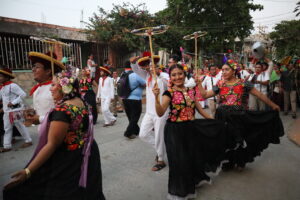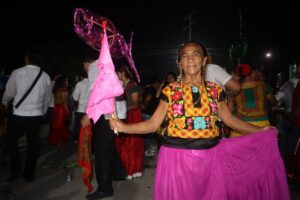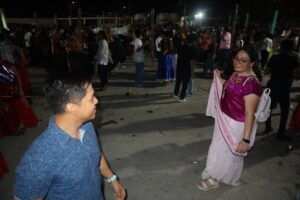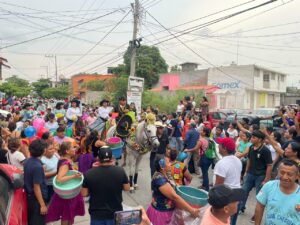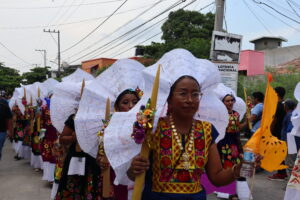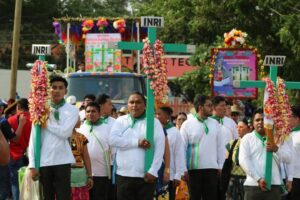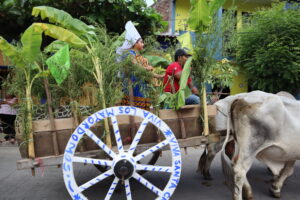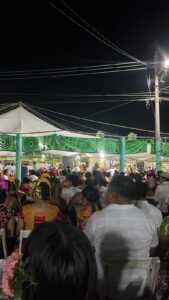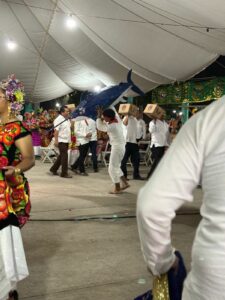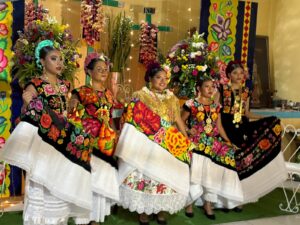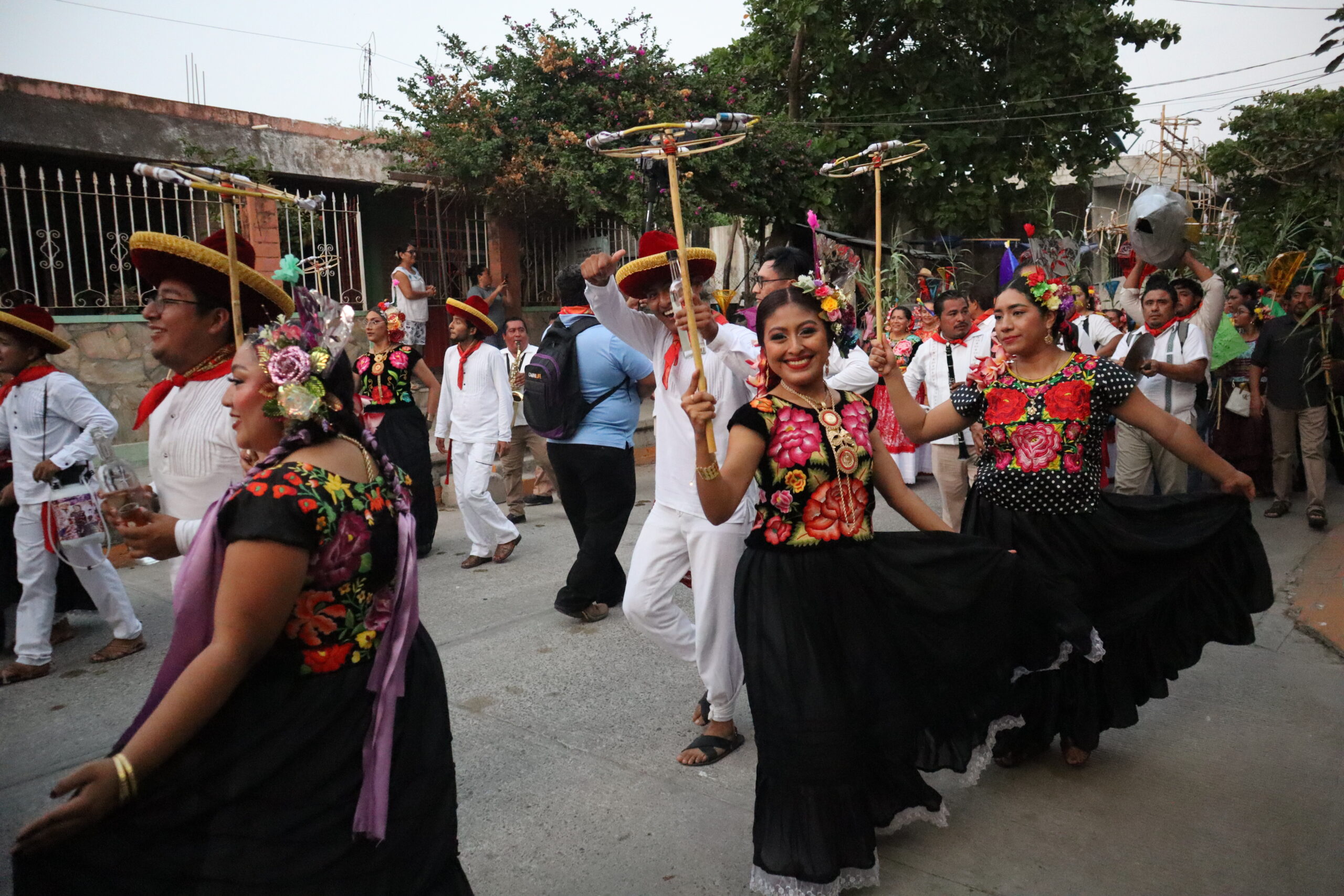May is a month of great cultural significance in Juchitán de Zaragoza, Oaxaca, due to the celebration of the Velas Istmeñas, one of the most emblematic traditions of the Zapotec people from the Isthmus of Tehuantepec. These festivities blend Indigenous and Catholic elements and are a vibrant expression of identity, community, and cultural resilience.
Although these traditions have been preserved, they have also evolved with a distinctive cultural style. The city is officially divided into nine numbered sections, each with apparent social and ritual significance related to affiliations with voluntary associations and the sponsorship of the velas. This year, the town’s festivities began in the Seventh Section, where key interest groups connected to the Bií Hioxo wind farm are located.
The fishermen, second in number only to the farmers, live in this part of Juchitán, with direct access to the lagoons where fishing takes place. It is in this area where the festivities of Santa Cruz Guzebenda (Holy Cross of the Fishermen) are held.
The team from the Nacanu’ Bií Community Center received ethnographic training on Juchitán from the Autonomous University of the State of Morelos, as part of the “Guidxiguie’: Tie’ ne nayecyhe” – Juchitán, Color and Joy project. The initiative seeks to document Juchitán’s cultural expressions and understand how the community manages its physical and symbolic resources.
For this reason, they participated in the traditional festivities of Santa Cruz Guzebenda, strengthening the Social Relationship Model with the community of the Seventh Section, respecting its local idiosyncrasy and reinforcing Zapotec cultural and social bonds.
During the event, the social engagement team took part in various cultural activities such as the calenda, vela, regada, and lavada de ollas, proudly wearing traditional attire and embodying values of inclusion and respect.
The Calenda
The calenda is the parade that marks the beginning of the vela, regada, and lavada de ollas celebrations. This particular one took place on April 29, starting at the Church of Santa Cruz de los Pescadores in the Seventh Section, winding through the city’s main streets and returning to the same starting point.
Among the participants were the padrinos de calenda, the Guzebenda collective (Alex Guerra, Alex Ramón, and Luz Gerardo Suárez), the delegation of Ángel Regalado Gutiérrez and Ayleen Martínez, and the “La Populosa” collective, formed by Aris López Martínez and Lucelia Celaya López.
These hosts welcomed the parade at their doorsteps with traditional drinks, reed sticks decorated with balloons, fireworks, regional music, and lanterns, as the event took place in the late afternoon and evening.
Velas
The velas are perhaps the most iconic expression of Zapotec culture. In Juchitán—unlike many cities in the Isthmus—the number of velas has been preserved, and some that had vanished have been revived. Entry to these events is free: men must bring a case of beer, and women a donation, both to be given to the host, while wearing traditional clothing.
Vela societies date back at least to the mid-19th century. While they have a religious nature, they function mainly as social organizations. They include both men and women: men with a governing board (president, secretary, treasurer, and board members), and women led by the guzana gola and her two to five assistants.
The mayordomo role completes the leadership structure and is typically filled by a man and a woman who are not necessarily a couple. These are usually senior, respected, and affluent members due to the high cost of hosting the vela. This year, the mayordomos for the Santa Cruz Guzebenda vela (of the fishermen) were Agustín Valdiviezo Santiago and Gloria Sánchez López, who handed over the role to Dr. Manuel García Sánchez and Francisco García Sánchez.
On the night of Wednesday, April 30, the community paid tribute to fishing, giving thanks for the abundance of fish, shrimp, and crabs. A tribute was also made to the Holy Cross at the fishermen’s dance floor in the heart of the Seventh Section. The vela began around 9 p.m. with the arrival of the different groups, each announced by a brass band and accompanied by women carrying trays of snacks to share.
Outside the dance floor, beer vendors and food stalls selling traditional snacks like garnachas and tlayudas were set up. The transfer of the mayordomo role took place around 11 p.m., with the outgoing hosts handing over candles made during the Labrada day. The evening ended with the Son Guzebenda dance, a deeply symbolic tune that brings the celebration to a close.
Regada
On May 2, the regada was held, involving 41 captains. They gathered at a predetermined meeting point and then headed to the fishermen’s church. Along the way, they handed out toys, plastic items, household goods, and even dried fish to onlookers.
The parade was led by decorated carts carrying women of the society, followed by the mayordomos with their candles, then women carrying lit candles, followed by floats featuring the captains and their companions, horse-riding captains, and finally the atarrayeros—fishermen who symbolically cast their nets over the crowd to carry away bad energy to the sea.
In the past, this celebration was known as the Fruit Regada, where captains gave part of their harvest or catch to the community as an offering of gratitude to the Holy Cross, symbolizing future prosperity.
Lavada de ollas
The lavada de ollas is the final activity in the vela festivities. For Santa Cruz Guzebenda, it was held on May 3, starting at dawn with mañanitas to the Holy Cross, followed by a mass. At 4:00 p.m., the dxi laní (“the day”) activity began, marking the start of additional celebrations in honor of fish, lizards, corn, plum trees, and clay pitchers.
The calendas, velas, regadas, and lavadas de ollas of Juchitán represent unity, cooperation, abundance, and tradition. At a celebration in Juchitán, no one goes without food, drink, or dance.
